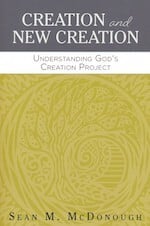The Thirteenth Station: Jesus Dies on the Cross
Daily Reflection / Produced by The High Calling
It was now about noon, and darkness came over the whole land until three in the afternoon, while the sun’s light failed; and the curtain of the temple was torn in two. Then Jesus, crying with a loud voice, said, “Father, into your hands I commend my spirit.” Having said this, he breathed his last. When the centurion saw what had taken place, he praised God and said, “Certainly this man was innocent.”
Luke 23:44
At first glance, Luke’s version of the centurion’s response to Jesus’ death seems like a glaring understatement. “Certainly this man was innocent,” rightly identifies Jesus’ lack of guilt. It makes clear once again the fact that he didn’t deserve to be crucified for sedition against Rome. He was no ordinary revolutionary, no guerrilla warrior, no terrorist. So, yes, “this man was innocent.” But couldn’t Luke have done better than this in his telling of the story? Mark’s version (15:39) seems so much stronger: “Truly this man was God’s Son!”
We can’t be sure why Luke fashioned the narrative of Jesus’ death as he did. But we can understand that “Certainly this man was innocent” carried more weight with Luke than it might seem. Some translations, including the classic King James, have, “Certainly this was a righteous man” (23:47). This is a literal translation of the Greek, which uses the word dikaios to describe Jesus. Dikaios can mean "innocent", but it is the usual word for “righteous,” and the base of such words as “righteousness, justice, justification” (dikaiosyne) and “justify” (dikaioo). From the lips of the centurion comes something far more than a recognition of Jesus’ innocence. It’s an ironic confession of his character as the righteous one, indeed, The Righteous One of God.
That Jesus was The Righteous One identifies him with the Suffering Servant from Isaiah 53. In this classic passage we read:
He was despised and rejected by others;
a man of suffering and acquainted with infirmity;
and as one from whom others hide their faces
he was despised, and we held him of no account.
Surely he has borne our infirmities
and carried our diseases;
yet we accounted him stricken,
struck down by God, and afflicted.
But he was wounded for our transgressions,
crushed for our iniquities;
upon him was the punishment that made us whole,
and by his bruises we are healed.
All we like sheep have gone astray;
we have all turned to our own way,
and the LORD has laid on him
the iniquity of us all...
Out of his anguish he shall see light;
he shall find satisfaction through his knowledge.
The righteous one [ho dikaios], my servant, shall make many righteous,
and he shall bear their iniquities.
Therefore I will allot him a portion with the great,
and he shall divide the spoil with the strong;
because he poured out himself to death,
and was numbered with the transgressors;
yet he bore the sin of many,
and made intercession for the transgressors.
(Isa. 53:4-6, 11-12)
Because Jesus was righteous, because he was innocent, not just of crimes that deserved crucifixion, but of all wrongdoing, he was able to make many righteous by bearing the sin of others. He became the spotless sacrifice for all people. Thus, his being The Righteous One is absolutely essential for his death on the cross to bring about our salvation.
One of my favorite passages from the New Testament explains in theological language the import of Jesus’ death: “For our sake he made him to be sin who knew no sin, so that in him we might become the righteousness of God” (2 Cor. 5:21). Simply put, God made Christ to be sin in that he became an offering for sin, taking our place in receiving the death that sin deserves. Christ was able to do this because he was The Righteous One. In exchange, we receive his own righteousness (dikaiosyne), the very righteousness of God. Through Christ, we are brought back into right relationship with the living God and begin the process of being made fully right, just like Jesus.
So, the apparently simple expression of the centurion, “Certainly this man was innocent” turns out to mean much more than it suggests on the surface. Jesus was not just innocent, but righteous. And he was not just any old righteous person, but The Righteous One who came to fulfill the role of the Suffering Servant. Through his righteous life, and through his sacrificial death, we receive the gift of his own righteousness. What a wonder!
I close today with the wonderful poetry of the classic hymn, “The Solid Rock,” by Edward Mote:
My hope is built on nothing less
Than Jesus’ blood and righteousness;
I dare not trust the sweetest frame,
But wholly lean on Jesus’ name.
On Christ, the solid Rock, I stand;
All other ground is sinking sand,
All other ground is sinking sand.
When darkness seems to hide his face,
I rest on his unchanging grace;
In ev’ry high and stormy gale,
My anchor holds within the veil.
On Christ, the solid Rock, I stand;
All other ground is sinking sand,
All other ground is sinking sand.
His oath, his covenant, his blood
Support me in the whelming flood;
When all around my soul gives way,
He then is all my hope and stay.
On Christ, the solid Rock, I stand;
All other ground is sinking sand,
All other ground is sinking sand.
When he shall come with trumpet sound,
Oh, may I then in him be found;
Dressed in his righteousness alone,
Faultless to stand before the throne.
On Christ, the solid Rock, I stand;
All other ground is sinking sand,
All other ground is sinking sand.
QUESTIONS FOR FURTHER REFLECTION: What difference might it make in your life if you truly believed you were dressed in the righteousness of Christ?
PRAYER: Merciful Lord, thank you for being The Righteous One. Thank you for your perfect life and your sacrificial death. Thank you for taking my sin upon yourself, and giving me your righteousness in return.
Like the centurion, I look upon your cross today with wonder. But I’m not only struck by your legal innocence. I’m astounded by your willingness to suffer and die for me, the Righteous One for the unrighteous. All praise be to you, glorious, gracious, giving Lord! Amen.
P.S. You can see Linda’s painting for the Thirteenth Station here.








